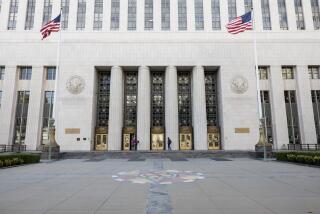Let TV Be a Window to Courts
American Bar Assn. President Philip S. Anderson declared last week, “I cannot think of a better civics lesson for the people of America [than] to be able to see and hear every argument before the Supreme Court of the United States.” He is right.
At a time of growing distrust of the judicial system and when, according to a recent survey, only 2% of teenagers know who the chief justice is, more exposure should be an antidote. Anderson has called on the Supreme Court and all lesser courts to open their doors to television cameras.
The success of American democracy rests on its openness. Congress generally acts in public, and the president must publicly account for his actions. So must the courts: They must adapt to the new ways in which Americans get information.
Reserving a few seats in courtrooms for spectators and reporters is not the same as letting a TV audience see the arguments and opinions delivered. Cameras have been a tough sell to judges, who worry that attorneys would posture, that the privacy of witnesses and jurors would be invaded and that courtroom decorum would be destroyed--even though procedural safeguards can prevent these results. Judges also fear that the camera will memorialize a questionable ruling or poor trial management. As a result, no federal district courts now permit trials to be televised. The Supreme Court has never let in cameras, and only two of the 13 U.S. courts of appeals currently allow them. A 1997 rule change gave California trial judges new latitude to restrict the use of cameras in and around courtrooms, and judges have often used it to keep cameras out.
Judges regularly lament the public’s resistance to jury duty, low voter turnout and eroding civic knowledge. They should respond by opening courthouse doors. As the ABA’s Anderson put it, cameras can “capture the majesty and grandeur and beauty of American justice.”
More to Read
Sign up for Essential California
The most important California stories and recommendations in your inbox every morning.
You may occasionally receive promotional content from the Los Angeles Times.










